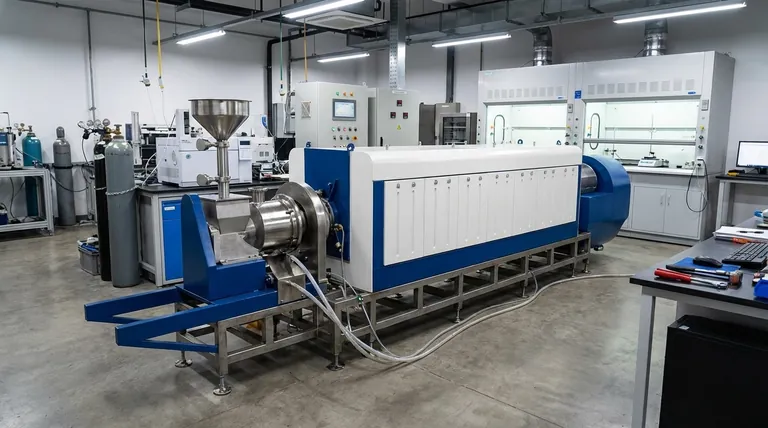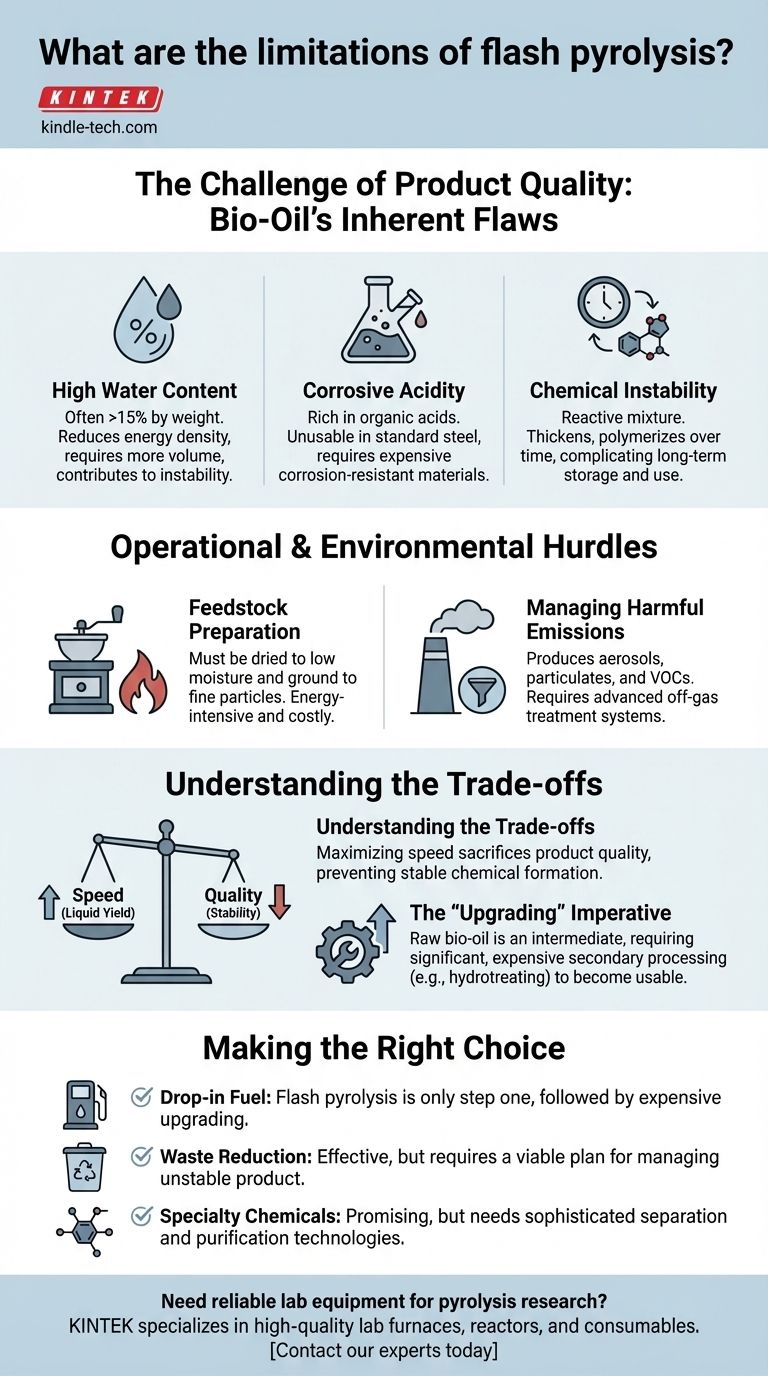At its core, flash pyrolysis is limited by two primary factors: the low quality of its primary product, bio-oil, and the significant operational complexity required to manage its process conditions and environmental impact. The resulting bio-oil is highly acidic, unstable, and has a high water content, making it unusable without substantial and costly secondary processing.
While flash pyrolysis excels at rapidly converting biomass into a liquid intermediate, its limitations mean it is not a one-step solution for fuel or chemical production. The process creates a challenging product that requires significant downstream investment and careful environmental management to be viable.

The Challenge of Product Quality: Bio-Oil's Inherent Flaws
The main output of flash pyrolysis, often called bio-oil or pyrolysis oil, is fundamentally different from conventional crude oil. Its chemical properties present major hurdles for storage, transport, and use.
High Water Content
The bio-oil produced is characterized by a high water content, often exceeding 15% by weight. This water is created during the pyrolysis reaction and is intimately mixed with the oil.
This high water content directly reduces the energy density of the fuel, meaning more volume is required to produce the same amount of energy as a conventional fuel. It also contributes to the oil's instability.
Corrosive Acidity
Flash pyrolysis breaks down cellulose and hemicellulose into a wide range of oxygenated compounds, including organic acids like acetic acid and formic acid. This makes the resulting bio-oil highly acidic and corrosive.
This acidity means that standard carbon steel tanks, pipes, and engine components cannot be used. Handling and storing bio-oil requires more expensive, corrosion-resistant materials like stainless steel, increasing infrastructure costs.
Chemical Instability
Unlike stable fossil fuels, bio-oil is a reactive mixture that changes over time. Its reactive components can polymerize, causing the oil to thicken, increase in viscosity, and even form solids.
This instability complicates long-term storage and makes it difficult to use in engines or reactors not specifically designed to handle it. The oil's properties can change significantly between production and end-use.
Operational and Environmental Hurdles
Beyond the product itself, the flash pyrolysis process introduces its own set of challenges that must be engineered and managed carefully.
Managing Harmful Emissions
The high temperatures and oxygen-deprived environment can produce a range of emissions, including aerosols, particulates, and volatile organic compounds. Without proper control, these can negatively impact air quality.
Ensuring the process is environmentally sound requires a significant investment in the proper design, operation, and maintenance of the furnace and off-gas treatment systems. This adds both capital and operational expense.
Feedstock Preparation
Flash pyrolysis is highly sensitive to the physical characteristics of its feedstock. To achieve the rapid heat transfer necessary, the biomass must be dried to a low moisture content and ground into very fine particles.
This pre-processing step is energy-intensive and costly, adding a significant operational burden before the core conversion process even begins.
Understanding the Trade-offs
The limitations of flash pyrolysis are a direct result of its core design trade-off: maximizing speed and liquid yield at the expense of product quality.
Speed vs. Quality
The very rapid heating rates ("flash") are what maximize the liquid oil yield. However, this speed prevents the chemical reactions from proceeding to a more stable, higher-quality state. Slower pyrolysis processes, by contrast, tend to produce less liquid oil but more stable byproducts like biochar and higher-quality syngas.
The "Upgrading" Imperative
Because of its instability, high water content, and corrosivity, raw bio-oil is almost never a final, "drop-in" product. It is an intermediate that requires significant secondary processing, known as upgrading.
Upgrading often involves catalytic processes like hydrotreating, which uses hydrogen at high pressure and temperature to remove oxygen and stabilize the oil. This is an expensive and complex refining step that is critical for producing usable fuels.
Making the Right Choice for Your Goal
Understanding these limitations is key to determining if flash pyrolysis is the right technology for your application.
- If your primary focus is creating a drop-in transportation fuel: Flash pyrolysis is only the first, and often cheapest, step in a long and expensive process that must include robust bio-oil upgrading.
- If your primary focus is waste volume reduction: The technology is effective, but you must have a clear and economically viable plan for managing the unstable, corrosive liquid product it creates.
- If your primary focus is producing specialty chemicals: Flash pyrolysis can be a promising route, but it requires sophisticated separation and purification technologies downstream to isolate valuable compounds from the complex bio-oil mixture.
Ultimately, approaching flash pyrolysis with a clear understanding of its inherent challenges is the first step toward successful implementation.
Summary Table:
| Limitation | Key Challenge | Impact |
|---|---|---|
| Bio-Oil Quality | High acidity, water content, and chemical instability | Requires costly secondary processing; not a drop-in fuel |
| Operational Complexity | Fine feedstock preparation and emission control | Increases capital and operational expenses |
| Environmental Management | Harmful emissions and waste handling | Requires advanced off-gas treatment systems |
| Product Utility | Unstable intermediate product | Limited direct use; necessitates upgrading for fuel/chemical production |
Need reliable lab equipment to analyze or optimize pyrolysis processes? KINTEK specializes in high-quality lab furnaces, reactors, and consumables designed for precise thermal processing and biomass conversion research. Our solutions help you manage complex pyrolysis parameters and achieve consistent results. Contact our experts today to find the right equipment for your laboratory needs!
Visual Guide

Related Products
- Electric Rotary Kiln Small Rotary Furnace Biomass Pyrolysis Plant
- Customizable High Pressure Reactors for Advanced Scientific and Industrial Applications
- High Pressure Laboratory Autoclave Reactor for Hydrothermal Synthesis
- Mini SS High Pressure Autoclave Reactor for Laboratory Use
- Stainless High Pressure Autoclave Reactor Laboratory Pressure Reactor
People Also Ask
- What are the conditions for biomass pyrolysis? Optimize Temperature, Heating Rate & Time
- What are the advantages of pyrolysis technology? Turn Waste into Profit and Reduce Emissions
- What are the products of pyrolysis of biomass? Unlock Bio-Char, Bio-Oil, and Syngas
- What is a disadvantage of biomass energy? The Hidden Environmental and Economic Costs
- What are the reactions involved in pyrolysis of biomass? Unlock the Chemistry for Tailored Bio-Products



















